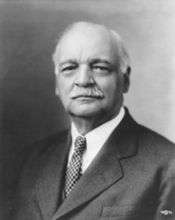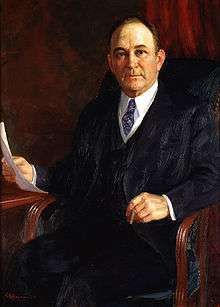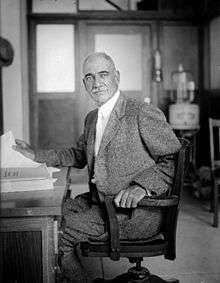70th United States Congress
| 70th United States Congress | |||||||||||||||||||||||||||||
| |||||||||||||||||||||||||||||
The Seventieth United States Congress was a meeting of the legislative branch of the United States federal government, consisting of the United States Senate and the United States House of Representatives. It met in Washington, D.C. from March 4, 1927 to March 4, 1929, during the last two years of Calvin Coolidge's presidency. The apportionment of seats in the House of Representatives was based on the Thirteenth Decennial Census of the United States in 1910. Both chambers had a Republican majority.
Major events
- November 6, 1928: U.S. Senate elections and U.S. House elections
Major legislation
- March 10, 1928: Settlement of War Claims Act
- May 15, 1928: Flood Control Act of 1928 (Jones–Reid Act)
- May 22, 1928: Merchant Marine Act of 1928 (Jones–White Act)
- May 22, 1928: Forest Research Act (McSweeney–McNary Act)
- May 22, 1928: Capper–Ketcham Act
- May 28, 1928: Welsh Act
- May 29, 1928: Revenue Act of 1928, ch. 852, 45 Stat. 791
- May 29, 1928: Reed–Jenkins Act
- December 21, 1928: Boulder Canyon Project Act (Hoover Dam)
- December 22, 1928: Color of Title Act
- January 19, 1929: Hawes–Cooper Act
- February 18, 1929: Migratory Bird Conservation Act (Norbeck–Anderson Act), ch. 257, 45 Stat. 1222
- March 2, 1929: Increased Penalties Act (Jones–Stalker Act)
Party summary



The count below identifies party affiliations at the beginning of the first session of this Congress, and includes members from vacancies and newly admitted states, when they were first seated. Changes resulting from subsequent replacements are shown below in the "Changes in membership" section.
Senate
| Party (shading shows control) |
Total | Vacant | |||
|---|---|---|---|---|---|
| Democratic (D) |
Farmer–Labor (FL) | Republican (R) | |||
| End of the previous congress | 42 | 1 | 53 | 96 | 0 |
| Begin | 47 | 1 | 48 | 96 | 0 |
| End | 45 | 50 | |||
| Final voting share | 46.9% | 1.0% | 52.1% | ||
| Beginning of the next congress | 39 | 1 | 55 | 95 | 1 |
House of Representatives
| Party (shading shows control) |
Total | Vacant | |||||
|---|---|---|---|---|---|---|---|
| Democratic (D) |
Farmer–Labor (FL) | Republican (R) | Socialist (S) | Other | |||
| End of the previous congress | 183 | 3 | 247 | 1 | 1 | 435 | 0 |
| Begin | 204 | 5 | 224 | 1 | 0 | 434 | 1 |
| End | 203 | 219 | 428 | 7 | |||
| Final voting share | 47.4% | 1.2% | 51.2% | 0.2% | 0.0% | ||
| Beginning of the next congress | 164 | 1 | 270 | 0 | 0 | 435 | 0 |
Leadership
Senate
Majority (Republican) leadership
Minority (Democratic) leadership
House of Representatives
Majority (Republican) leadership
Minority (Democratic) leadership
Members
This list is arranged by chamber, then by state.
Senate
Senators are listed in order of seniority at the beginning of this Congress.
Senators were elected every two years, with one-third beginning new six-year terms with each Congress. Preceding the names in the list below are Senate class numbers, which indicate the cycle of their election. In this Congress, Class 1 meant their term ended with this Congress, requiring re-election in 1928; Class 2 meant their term began in the last Congress, requiring re-election in 1930; and Class 3 meant their term began with this Congress, requiring re-election in 1932.
House of Representatives
- Alabama
- Alaska
- Arizona
- Arkansas
- California
- Colorado
- Connecticut
- Delaware
- Florida
- Georgia
- Hawaii
- Idaho
- Illinois
- Indiana
- Iowa
- Kansas
- Kentucky
- Louisiana
- Maine
- Maryland
- Massachusetts
- Michigan
- Minnesota
- Mississippi
- Missouri
- Montana
- Nebraska
- Nevada
- New Hampshire
- New Jersey
- New Mexico
- New York
- North Carolina
- North Dakota
- Ohio
- Oklahoma
- Oregon
- Pennsylvania
- Rhode Island
- South Carolina
- South Dakota
- Tennessee
- Texas
- Utah
- Vermont
- Virginia
- Washington
- West Virginia
- Wisconsin
- Wyoming
- Non-voting members
Members of the House of Representatives are listed by district.
Changes in membership
The count below reflects changes from the beginning of the first session of this Congress.
Senate
| State | Senator | Reason for Vacancy | Successor | Date of Successor's Installation |
|---|---|---|---|---|
| Pennsylvania (3) |
Vacant | the election of William S. Vare was refused to be certified by the governor, and the Senate could not agree to his being seated. | Vacant | Seat remained vacant until the next Congress |
| Illinois (3) |
Vacant | Frank L. Smith was not permitted to qualify, and resigned February 9, 1928. Winner was elected to finish the term. |
Otis F. Glenn (R) | December 3, 1928 |
| New Mexico (1) |
Andrieus A. Jones (D) | Died December 20, 1927 Successor was appointed to continue the term. |
Bronson M. Cutting (R) | December 29, 1927 |
| Michigan (1) |
Woodbridge N. Ferris (D) | Died March 23, 1928 Successor was appointed to continue the term. Successor was then elected November 6, 1928 to finish the term. |
Arthur H. Vandenberg (R) | March 31, 1928 |
| Ohio (3) |
Frank B. Willis (R) | Died March 30, 1928. Successor was appointed to continue the term. |
Cyrus Locher (D) | April 4, 1928 |
| Idaho (3) |
Frank R. Gooding (R) | Died June 24, 1928. Successor was appointed to continue the term. Successor was then elected November 6, 1928 to finish the term. |
John W. Thomas (R) | June 30, 1928 |
| New Mexico (1) |
Bronson M. Cutting (R) | Appointee resigned December 6, 1928 when successor was elected to finish the term. | Octaviano A. Larrazolo (R) | December 7, 1928 |
| Delaware (2) |
T. Coleman du Pont (R) | Resigned December 9, 1928. Successor was elected to finish the term. |
Daniel O. Hastings (R) | December 10, 1928 |
| Ohio (3) |
Cyrus Locher (D) | Appointee resigned December 14, 1928 when successor was elected to finish the term. | Theodore E. Burton (R) | December 15, 1928 |
House of Representatives
- Replacements: 15
- Democratic: 1 seat net gain
- Republican: 1 seat net loss
- Deaths: 16
- Resignations: 7
- Total seats with changes: 23
| District | Vacator | Reason for Vacancy | Successor | |
|---|---|---|---|---|
| Ohio 2nd | Vacant | Rep. Ambrose E. B. Stephens died during previous congress | Charles Tatgenhorst, Jr. (R) | November 8, 1927 |
| Louisiana 7th | Ladislas Lazaro (D) | Died March 30, 1927 | René L. De Rouen (D) | August 23, 1927 |
| New York 35th | Walter W. Magee (R) | Died May 25, 1927 | Clarence E. Hancock (R) | November 8, 1927 |
| Colorado 1st | William N. Vaile (R) | Died July 2, 1927 | S. Harrison White (D) | November 15, 1927 |
| Oregon 3rd | Maurice E. Crumpacker (R) | Died July 24, 1927 | Franklin F. Korell (R) | October 18, 1927 |
| Pennsylvania 1st | James M. Hazlett (R) | Resigned October 20, 1927 | James M. Beck (R) | November 8, 1927 |
| Iowa 9th | William R. Green (R) | Resigned March 31, 1928 after being appointed to the United States Court of Claims | Earl W. Vincent (R) | June 4, 1928 |
| Massachusetts 12th | James A. Gallivan (D) | Died April 3, 1928 | John W. McCormack (D) | November 6, 1928 |
| Illinois 1st | Martin B. Madden (R) | Died April 27, 1928 | Seat remained vacant until next Congress | |
| New York 32nd | Thaddeus C. Sweet (R) | Died May 1, 1928 | Francis D. Culkin (R) | November 6, 1928 |
| Pennsylvania 8th | Thomas S. Butler (R) | Died May 26, 1928 | James Wolfenden (R) | November 6, 1928 |
| Oregon 2nd | Nicholas J. Sinnott (R) | Resigned May 31, 1928 after being appointed to the United States Court of Claims | Robert R. Butler (R) | November 6, 1928 |
| Illinois At-large | Henry R. Rathbone (R) | Died July 15, 1928 | Seat remained vacant until next Congress | |
| Philippines At-large | Isauro Gabaldon | Resigned July 16, 1928 after being nominated for election to the Philippine House of Representatives | Seat remained vacant until next Congress | |
| Alabama 5th | William B. Bowling (D) | Resigned August 16, 1928 after being appointed judge of the 5th Judicial Circuit of Alabama | LaFayette L. Patterson (D) | November 6, 1928 |
| Massachusetts 14th | Louis A. Frothingham (R) | Died August 23, 1928 | Richard B. Wigglesworth (R) | November 6, 1928 |
| Missouri 16th | Thomas L. Rubey (D) | Died November 2, 1928 | Seat remained vacant until next Congress | |
| Arkansas 2nd | William Allan Oldfield (D) | Died November 19, 1928 | Pearl Peden Oldfield (D) | January 9, 1929 |
| Ohio 22nd | Theodore E. Burton (R) | Resigned December 15, 1928 after winning special election to the US Senate | Seat remained vacant until next Congress | |
| New York 41st | Clarence MacGregor (R) | Resigned December 28, 1928 after being appointed to the New York Supreme Court | Seat remained vacant until next Congress | |
| Missouri 4th | Charles L. Faust (R) | Died December 17, 1928 | David W. Hopkins (R) | February 5, 1929 |
| Illinois 15th | Edward J. King (R) | Died February 17, 1929 | Seat remained vacant until next Congress | |
| New York 21st | Royal H. Weller (D) | Died March 1, 1929 | Seat remained vacant until next Congress | |
Committees
Lists of committees and their party leaders.
Senate
- Agriculture and Forestry
- Appropriations
- Audit and Control the Contingent Expenses of the Senate
- Banking and Currency
- Civil Service
- Claims
- Commerce
- District of Columbia
- Education and Labor
- Enrolled Bills
- Expenditures in Executive Departments
- Finance
- Foreign Relations
- Illegal Appointments in Civil Service (Select)
- Immigration
- Immigration and Naturalization
- Indian Affairs
- Interoceanic Canals
- Interstate Commerce
- Judiciary
- Library
- Manufactures
- Mexican Propaganda (Select)
- Military Affairs
- Mines and Mining
- Naval Affairs
- Patents
- Pensions
- Post Office and Post Roads
- Presidential Campaign Expenditures (Special)
- Printing
- Privileges and Elections
- Propaganda or Money Alleged Used by Foreign Governments (Special)
- Public Buildings and Grounds
- Public Lands and Surveys
- Revision of the Laws
- Rules
- Senatorial Elections (Select)
- Tariff Commission (Select)
- Territories and Insular Possessions
- Whole
House of Representatives
- Accounts
- Agriculture
- Alcoholic Liquor Traffic
- Appropriations
- Banking and Currency
- Census
- Civil Service
- Claims
- Coinage, Weights and Measures
- Disposition of Executive Papers
- District of Columbia
- Education
- Election of the President, Vice President and Representatives in Congress
- Elections
- Enrolled Bills
- Expenditures in the Executive Departments
- Flood Control
- Foreign Affairs
- Immigration and Naturalization
- Indian Affairs
- Insular Affairs
- Interstate and Foreign Commerce
- Invalid Pensions
- Irrigation and Reclamation
- Labor
- Merchant Marine and Fisheries
- Military Affairs
- Mines and Mining
- Naval Affairs
- Patents
- Pensions
- Post Office and Post Roads
- Public Buildings and Grounds
- Public Lands
- Revision of Laws
- Rivers and Harbors
- Roads
- Rules
- Standards of Official Conduct
- Territories
- War Claims
- Ways and Means
- Whole
Joint committees
- Conditions of Indian Tribes (Special)
- Disposition of (Useless) Executive Papers
- Harriman Geographic Code System
- Investigation of Northern Pacific Railroad Land Grants
- Taxation
- To Investigate the Salaries of Officers and Employees of the Senate and the House
Officers
- Architect of the Capitol: David Lynn
- Attending Physician of the United States Congress: George Calver
- Comptroller General of the United States: John R. McCarl
- Librarian of Congress: Herbert Putnam
- Public Printer of the United States: George H. Carter
Senate
- Chaplain: John J. Muir, (Baptist)
- ZeBarney T. Phillips (Episcopal), from December 5, 1927
- Secretary: Edwin P. Thayer
- Sergeant at Arms: David S. Barry
House of Representatives
- Chaplain: James S. Montgomery (Methodist)
- Clerk: William T. Page
- Doorkeeper: Bert W. Kennedy
- Sergeant at Arms: Joseph G. Rodgers
- Parliamentarian: Lewis Deschler
- Postmaster: Frank W. Collier
See also
- United States elections, 1926 (elections leading to this Congress)
- United States elections, 1928 (elections during this Congress, leading to the next Congress)
References
- ↑ Frank L. Smith (R-IL) was elected to the Senate for the term starting March 4, 1927, but the Senate refused to qualify him due to charges of corruption concerning his election. He resigned February 9, 1928. See http://bioguide.congress.gov/scripts/biodisplay.pl?index=S000534
- ↑ William S. Vare (R-PA) was elected to the Senate for the term starting March 4, 1927, but the Senate refused to qualify him due to charges of corruption and fraud concerning his election. In the next Congress, the Senate unseated him. See http://bioguide.congress.gov/scripts/biodisplay.pl?index=V000071
- Martis, Kenneth C. (1989). The Historical Atlas of Political Parties in the United States Congress. New York: Macmillan Publishing Company.
- Martis, Kenneth C. (1982). The Historical Atlas of United States Congressional Districts. New York: Macmillan Publishing Company.
External links
- Biographical Directory of the U.S. Congress
- U.S. House of Representatives: House History
- U.S. Senate: Statistics and Lists
- Official Congressional Directory for the 70th Congress, 1st Session.
- Official Congressional Directory for the 70th Congress, 1st Session (Revision).
- Official Congressional Directory for the 70th Congress, 2nd Session.




.jpg)



